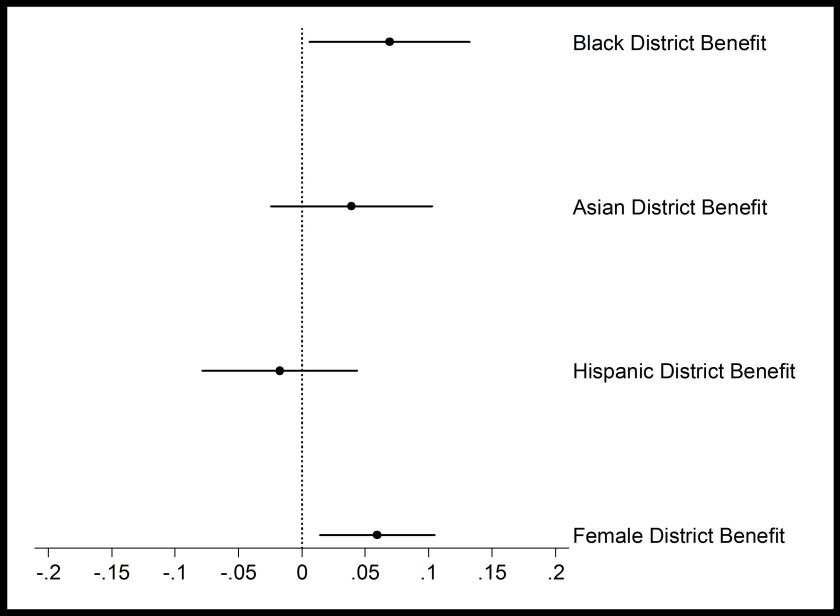The following is part of a series of posts written by 2016 MPSA award recipients highlighting outstanding research presented at previous MPSA annual conferences.
Women and racial and ethnic minorities hold far fewer political offices than one might expect given their presence in the American population. Even at the local level, where the barriers of entry to political careers are smaller, women hold only a quarter of city council seats, Blacks hold 6%, Latinos 3%, and Asian-Americans less than 1% of seats. And, plenty of research demonstrates that this underrepresentation matters for the kinds of policies that are created and implemented at the local level and thus for the quality of representation offered to all Americans.
Why are members of these groups so unlikely to hold political office? One explanation some have offered is that the structure of elections shapes the chances of success for women and minorities. But, the research offering this suggestion is quite inconsistent in its recommendations. District elections might be the solution for racial and ethnic minority representation – except in cases where they have limited or no effects. And at-large, multimember district elections are the recommended mechanism to increase women’s representation – except in cases where they don’t matter or actually decrease the number of female candidates and elected officials. Despite an enormous amount of research on the connection between electoral systems and the representation of underrepresented groups, we still do not have a clear understanding of what structures positively or negatively affect representation for women and racial and ethnic minorities.
Why does this lack of clarity persist? In short, because existing scholarship has been unable to determine exactly how institutions and representation are linked. In this paper, we test a mechanism that has been ignored in existing research: voter use of stereotypes when choosing officials. We argue that the difficulty of the voting decision itself can make voters more or less likely to rely on stereotypes in the voting booth. Specifically, we propose that district elections, which frequently feature just two major candidates, present a cognitively simpler task than at-large elections in which voters are asked to make multiple selections among a large field of contenders. When the cognitive task is simplified, voters are more likely to be able to suppress negative stereotypes that are inconsistent with their personal beliefs or desire to respond in a socially appropriate way. In other words, district elections may yield more support for candidates from underrepresented groups for reasons that have nothing to do with common explanations in the literature like geographic segregation or polarized voting.
We test this theory using a set of experiments in which people vote in either “district” elections (selecting 1 of 2 candidates) or “at-large” elections (selecting 3 of 6 candidates) for a variety of local offices. We modeled our elections after typical local elections, where voters know very little about the candidates on the ballot. In the experiments, voters choose between candidate images. These images suggest a candidate’s race, ethnicity, and gender, but have been selected not to differ in other ways that might influence votes. This is similar to contexts where voters identify candidates only by their images on a direct mail piece or campaign sign. We conducted our experiments among two very different populations and found consistent results.
As the below figure demonstrates, we found that female and Black candidates are advantaged in district over at-large elections. In other words, when voters are selecting only one of two candidates, they’re more likely to pick a Black candidate or a female candidate than when they’re faced with the more difficult decision of selecting three candidates out of six offered to them. Thus, we find an effect of election structure on the likelihood of success for female and Black candidates that cannot be due to the explanations proposed in previous studies.

Is this positive effect of district elections for Black and female candidates because of our proposed mechanism – that voters can work to overcome their negative stereotypes about these less-traditional candidates when faced with an easier voting decision, but when they’re exhausted by the more difficult at-large ballot they are more likely to rely on negative stereotypes to make a voting decision? Two additional findings suggest support for this theory:
First, we find that our results – the district benefit for women and Blacks – are being driven by respondents who are not themselves female or Black. Women vote for female candidates and minorities vote for minority candidates at similar rates in at-large and district elections. The gap between district and at-large election success appears for female candidates among male voters, and for Black candidates among white voters, suggesting that the voters who have a harder time voting for less-traditional candidates when faced with more difficult (at-large) elections are those who are more likely to hold negative views about those groups – because they are not members of their ingroup.
Second, we find that people who willingly express lower support for gender equality and higher levels of racial resentment vote for women and Blacks at similar rates in both district and at-large elections. The effect of district elections on success for female and Black candidates instead shows up among people who explicitly indicate beliefs in gender equality and less racial resentment. In other words, the people who we’d expect to want to overcome negative stereotypes they may hold about candidates from non-traditional groups are the ones who do so in district elections.
In sum, we find that electoral structure matters for who is elected because of how it influences voters. Even those voters motivated to support diverse candidates appear to be less able to realize those preferences in at-large contests compared to districts. This suggests that other electoral contexts that impose greater cognitive difficulty on voters may also diminish support for candidates from groups about which there are broadly held negative attitudes. For example, elections with particularly long ballots, or that involve referendum decisions that tax a voter’s cognitive resources may diminish the chances of success for female and minority candidates on those ballots.
 About the Authors: Melody Crowder-Meyer is an Assistant Professor in the Department of Politics at University of the South, Shana Kushner Gadarian is an Associate Professor in the Department of Political Science in the Maxwell School of Citizenship and Public Affairs, Syracuse University, Jessica Trounstine is an Associate Professor of Political Science at University of California, Merced, and Kau Vue is a Graduate Student at University of California-Merced. Their research “Complex Interactions: Candidate Race, Sex, Electoral Institutions, and Voter Choice” was awarded the Sophonisba Breckinridge Award for the best paper on the topic of women and politics at the 2016 MPSA Conference.
About the Authors: Melody Crowder-Meyer is an Assistant Professor in the Department of Politics at University of the South, Shana Kushner Gadarian is an Associate Professor in the Department of Political Science in the Maxwell School of Citizenship and Public Affairs, Syracuse University, Jessica Trounstine is an Associate Professor of Political Science at University of California, Merced, and Kau Vue is a Graduate Student at University of California-Merced. Their research “Complex Interactions: Candidate Race, Sex, Electoral Institutions, and Voter Choice” was awarded the Sophonisba Breckinridge Award for the best paper on the topic of women and politics at the 2016 MPSA Conference.
